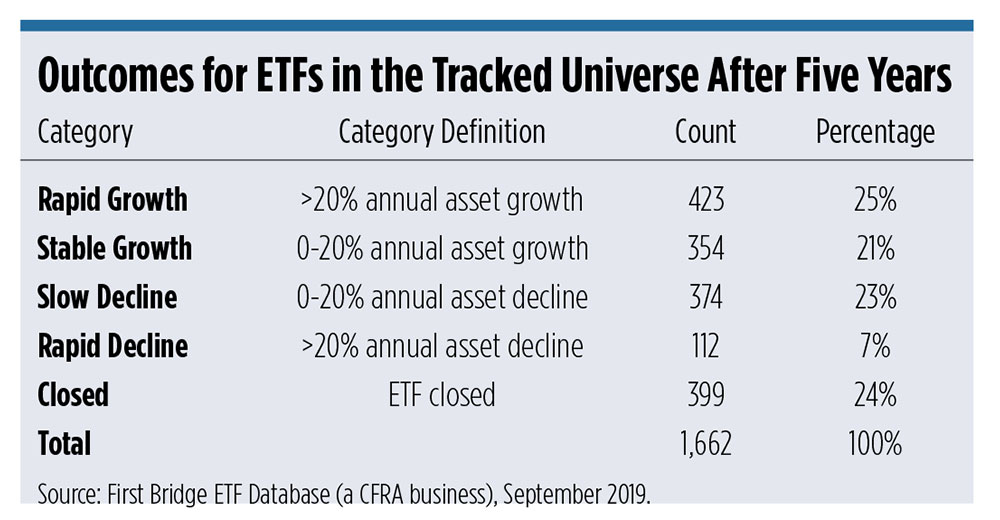Nearly a quarter (24%) of the 1,662 exchange traded funds that existed five years ago have closed down, a significant portion of the universe, according to a new analysis by CFRA. The independent research firm recently looked at the ETF universe that existed in December 2014 and studied how that cohort performed through August 2019. Their conclusions point to signs that a given fund is not going to survive long term.
The top predictor of closures is assets under management, according to Aniket Ullal, vice president of ETF data and analytics. In fact, the ETFs that closed had median assets of $10 million in December 2014. Further, 89% of shuttered funds never crossed the $100 million mark, which many believe to be the asset threshold for ETFs to reach sustainability.
“There’s a whole range of ETFs that started out small and never got their traction to cross $100 million into viability,” Ullal said.
“Brokerage firms will not allow advisors to buy an ETF that has too little in assets under management,” said Todd Rosenbluth, head of ETF and mutual fund research at CFRA. “One of the reasons are, they don’t want to deal with the headaches of a closure. So it’s a circular problem that takes place. If you can’t gather assets initially out of the gate, you’re subject to being closed. If you can’t gather assets out of the gate, you can’t get distribution, which then could cause you to do that. That can be a challenge for folks.”
Assets aside, of the nearly 400 funds that closed over the past five years, more than one-third (34%) were exchange traded notes, index linked unsecured debt securities. Most ETNs failed to gain traction with investors because they must take on the credit risk of the issuer with these products, Ullal said. Many ETNs are specialized in terms of investor objectives; the top 10 closures were either ETNs or target maturity products, which have fixed maturity dates and just “died of natural causes,” he added. That includes the Guggenheim BulletShares 2017 Corporate Bond (BSCH).
Further, many ETFs that shut down were highly specialized international funds, such as the WisdomTree Asia Local Debt fund (ALD), iShares MSCI Eastern Europe fund (ESR) and Invesco Chinese Yuan Dim Sum Bond fund (DSUM).
A fund closure would cause a taxable event for the clients of an advisor, because they are forced to sell out of an ETF when they weren’t intending to. “So one of the tax efficiency benefits of ETFs disappears,” Rosenbluth said.

It’s little surprise that Vanguard and BlackRock dominated over the past five years in asset flows, with 18 of the top 20 fastest-growing ETFs during the period coming out of these companies. Yet, other large product sponsors also had rapid growth during the period. CFRA found that all major sponsors had outcomes over the five-year period ranging from rapid growth to closure. At State Street, for instance, 33% of its ETFs that existed in December 2014 experienced rapid growth (more than 20% annual asset growth), while 24% of its ETFs closed.
Vanguard was the only outlier, with 70% of its ETFs experiencing rapid growth. It had only 1% in slow decline (0%-20% annual asset decline) and zero closures.





